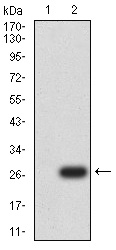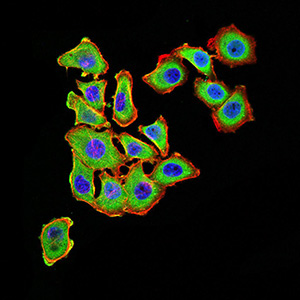Mouse Monoclonal Antibody to UCP3
Purified Mouse Monoclonal Antibody
- 产品详情
- 实验流程
Application
| WB, ICC, E |
|---|---|
| Primary Accession | P55916 |
| Reactivity | Human |
| Host | Mouse |
| Clonality | Monoclonal |
| Clone Names | 6B8C6 |
| Isotype | Mouse IgG2a |
| Calculated MW | 34216 Da |
| Description | Mitochondrial uncoupling proteins (UCP) are members of the larger family of mitochondrial anion carrier proteins (MACP). UCPs separate oxidative phosphorylation from ATP synthesis with energy dissipated as heat, also referred to as the mitochondrial proton leak. UCPs facilitate the transfer of anions from the inner to the outer mitochondrial membrane and the return transfer of protons from the outer to the inner mitochondrial membrane. They also reduce the mitochondrial membrane potential in mammalian cells. The different UCPs have tissue-specific expression; this gene is primarily expressed in skeletal muscle. This gene's protein product is postulated to protect mitochondria against lipid-induced oxidative stress. Expression levels of this gene increase when fatty acid supplies to mitochondria exceed their oxidation capacity and the protein enables the export of fatty acids from mitochondria. UCPs contain the three solcar protein domains typically found in MACPs. Two splice variants have been found for this gene.; |
| Immunogen | Purified recombinant fragment of human UCP3 (AA: 1-113 and 217-312) expressed in E. Coli. |
| Formulation | Purified antibody in PBS with 0.05% sodium azide |
| Application Note | ELISA: 1/10000; WB: 1/500 - 1/2000; ICC: 1/200 - 1/1000; |
| Gene ID | 7352 |
|---|---|
| Other Names | SLC25A9 |
| Dilution | WB~~1:1000 ICC~~N/A E~~N/A |
| Storage | Maintain refrigerated at 2-8°C for up to 6 months. For long term storage store at -20°C in small aliquots to prevent freeze-thaw cycles. |
| Precautions | Mouse Monoclonal Antibody to UCP3 is for research use only and not for use in diagnostic or therapeutic procedures. |
| Name | UCP3 {ECO:0000303|PubMed:9180264, ECO:0000312|HGNC:HGNC:12519} |
|---|---|
| Function | Putative transmembrane transporter that plays a role in mitochondrial metabolism via an as yet unclear mechanism (PubMed:21775425, PubMed:36114012). Originally, this mitochondrial protein was thought to act as a proton transmembrane transporter from the mitochondrial intermembrane space into the matrix, causing proton leaks through the inner mitochondrial membrane, thereby uncoupling mitochondrial membrane potential generation from ATP synthesis (PubMed:11171965, PubMed:12670931, PubMed:12734183, PubMed:9305858). However, this function is controversial and uncoupling may not be the function, or at least not the main function, but rather a consequence of more conventional metabolite transporter activity (PubMed:11707458). |
| Cellular Location | Mitochondrion inner membrane {ECO:0000250|UniProtKB:P56501}; Multi-pass membrane protein |
| Tissue Location | Only in skeletal muscle and heart (PubMed:9305858). Also expressed in white and brown adipose tissues (PubMed:9305858). Is more expressed in glycolytic than in oxidative skeletal muscles |
Research Areas
For Research Use Only. Not For Use In Diagnostic Procedures.
Application Protocols
Provided below are standard protocols that you may find useful for product applications.
REFERENCES
1.J Biol Chem. 2011 Sep 16;286(37):32533-41. ; 2.Nutr Hosp. 2012 Jul-Aug;27(4):1190-5. ;
终于等到您。ABCEPTA(百远生物)抗体产品。
点击下方“我要评价 ”按钮提交您的反馈信息,您的反馈和评价是我们最宝贵的财富之一,
我们将在1-3个工作日内处理您的反馈信息。
如有疑问,联系:0512-88856768 tech-china@abcepta.com.























 癌症的基本特征包括细胞增殖、血管生成、迁移、凋亡逃避机制和细胞永生等。找到癌症发生过程中这些通路的关键标记物和对应的抗体用于检测至关重要。
癌症的基本特征包括细胞增殖、血管生成、迁移、凋亡逃避机制和细胞永生等。找到癌症发生过程中这些通路的关键标记物和对应的抗体用于检测至关重要。 为您推荐一个泛素化位点预测神器——泛素化分析工具,可以为您的蛋白的泛素化位点作出预测和评分。
为您推荐一个泛素化位点预测神器——泛素化分析工具,可以为您的蛋白的泛素化位点作出预测和评分。 细胞自噬受体图形绘图工具为你的蛋白的细胞受体结合位点作出预测和评分,识别结合到自噬通路中的蛋白是非常重要的,便于让我们理解自噬在正常生理、病理过程中的作用,如发育、细胞分化、神经退化性疾病、压力条件下、感染和癌症。
细胞自噬受体图形绘图工具为你的蛋白的细胞受体结合位点作出预测和评分,识别结合到自噬通路中的蛋白是非常重要的,便于让我们理解自噬在正常生理、病理过程中的作用,如发育、细胞分化、神经退化性疾病、压力条件下、感染和癌症。









